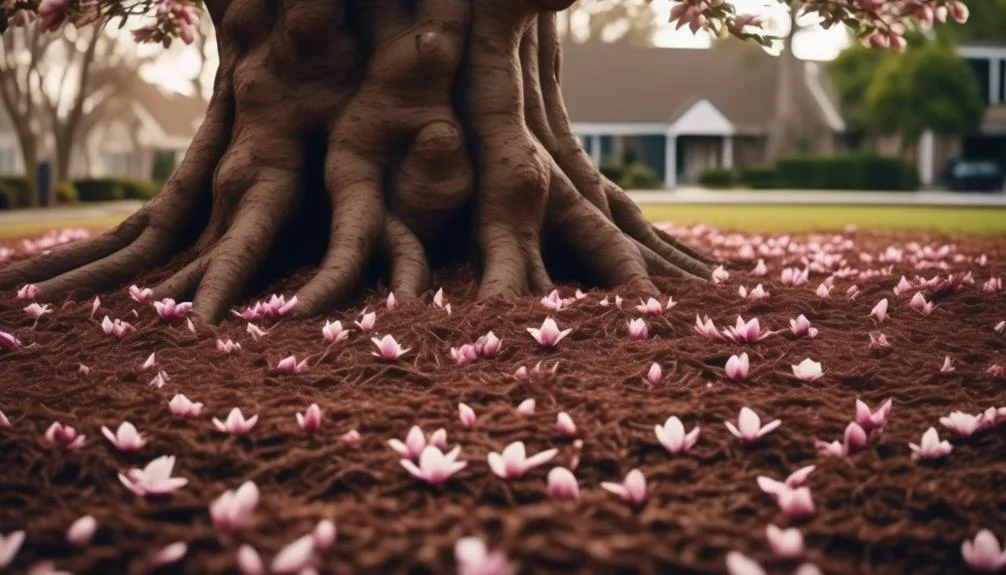Mulching your magnolia trees is essential for their health and beauty. Choosing the right mulch and applying it properly can make a big difference.
Whether you're new to gardening or have been doing it for years, understanding the best mulching techniques for magnolias is crucial for their well-being.
In this article, we'll explore the key techniques to help your magnolia trees thrive, ensuring a lush and vibrant landscape.
Selecting the Right Mulch
When selecting the right mulch for your magnolia tree, it's important to consider factors such as moisture retention, insulation, and weed suppression. Mulch types like wood chips, pine straw, or shredded leaves can all be effective choices.
The ideal mulch depth for magnolia trees is around 2-4 inches. This depth provides adequate insulation for the roots, helps retain moisture, and suppresses weed growth.
Wood chips are particularly good for moisture retention and insulation, while pine straw is lightweight and easy to spread. Shredded leaves decompose quickly, adding nutrients to the soil.
Regardless of the mulch type you choose, maintaining the proper depth is crucial for the overall health and vitality of your magnolia tree. Consider these factors to select the best mulch for your tree's needs.
Applying Mulch Correctly
Properly applying mulch to your magnolia tree is essential for maximizing its health and vitality. To ensure you're applying mulch correctly, follow these important steps:
- Proper Depth: Apply mulch around the base of the tree, keeping it at a depth of 2-4 inches to retain moisture and suppress weeds.
- Avoid Piling: Keep the mulch away from the trunk to prevent moisture-related issues and pests.
- Spread Evenly: Distribute the mulch evenly in a donut shape around the tree, extending to the drip line.
- Refresh Annually: Replenish the mulch yearly to maintain its benefits and appearance.
Maintaining Mulch Around Magnolia Trees
To ensure the health and vitality of your magnolia tree, maintaining the proper depth and distribution of mulch around the base is crucial.
Mulching frequency is essential for reaping the benefits of mulch, such as moisture retention and weed suppression. Regularly check the mulch depth, as it tends to compact and break down over time.
Ideally, the mulch should be maintained at a depth of 2-4 inches. Refresh the mulch as needed to maintain this depth, especially after heavy rain or strong winds.
Avoid piling mulch against the trunk of the magnolia tree, as this can lead to moisture retention against the bark, potentially causing rot.
Avoiding Common Mulching Mistakes
To ensure the optimal health of your magnolia tree, it's essential to be aware of common mulching mistakes and avoid them to support its well-being.
When mulching around your magnolia tree, preventing over mulching is crucial. Proper mulch depth, typically around 2-4 inches, allows for adequate air and water penetration while insulating the roots.
Avoid piling the mulch against the tree trunk to prevent moisture retention and potential rot. Additionally, refrain from using mulch that's too fine, as it can compact and prevent air and water from reaching the roots.
Lastly, remember to regularly inspect the mulch layer and adjust it as needed to maintain the ideal depth and ensure the health of your magnolia tree.
Benefits of Mulching for Magnolia Trees
Mulching your magnolia tree provides numerous benefits, including moisture retention, weed suppression, and soil insulation.
By retaining moisture, mulch helps in maintaining a consistent level of moisture in the soil, which is crucial for the healthy growth of magnolia trees. Additionally, it suppresses the growth of weeds, which compete with the tree for water and nutrients. This promotes the overall health and growth of your magnolia tree.
Moreover, mulch acts as an insulator, regulating soil temperature and protecting the roots from extreme heat or cold. This is especially important for magnolia trees, as it helps in improving soil quality and promoting growth.
Conclusion
Incorporating proper mulching techniques is pivotal for nurturing thriving magnolia trees. By carefully selecting and maintaining the right mulch, you can ensure the health and beauty of your magnolia trees.
Avoiding common mulching mistakes will lead to a more vibrant and robust magnolia tree. Embracing these practices will undoubtedly contribute to the long-term vitality of your magnolia trees.

My interest in trees started when I first saw the giant sequoias in Yosemite.
I was a teenager then, and I remember thinking, “I need to learn more about this.”
That moment stuck with me.
A few years later, I went on to study forestry at Michigan Tech.
Since graduating, I’ve worked in a mix of hands-on tree care and community education.
I’ve spent over ten years helping people understand how to plant, maintain, and protect the trees in their neighborhoods.
I don’t see trees as just part of the landscape.
They are living things that make a real difference in our daily lives.
